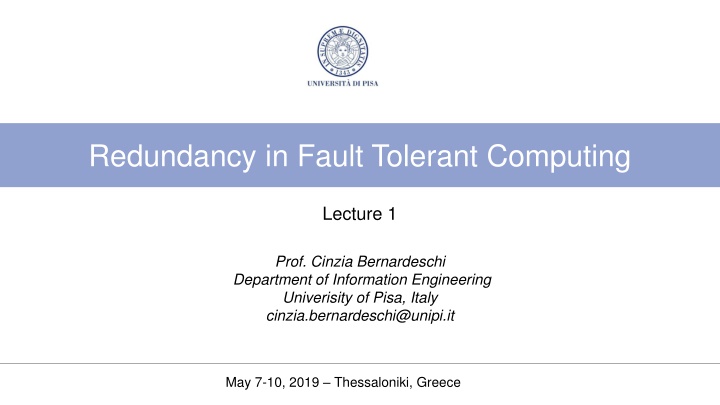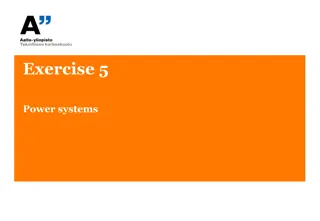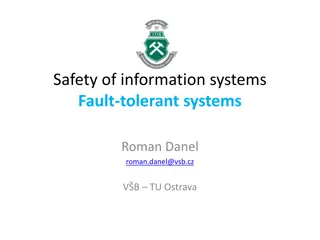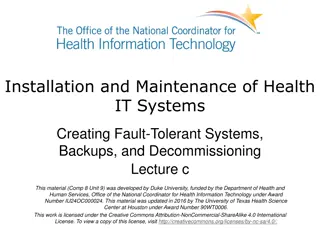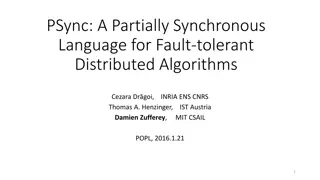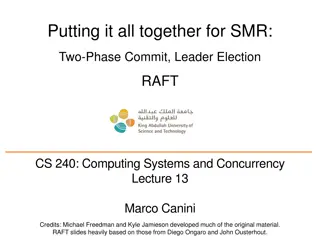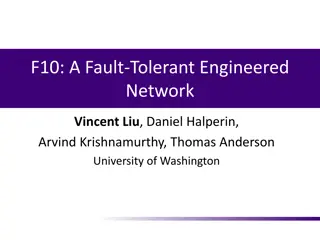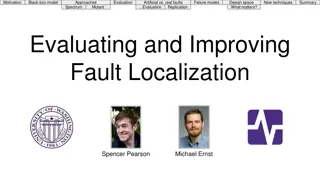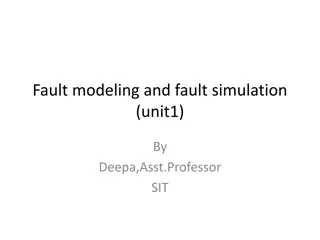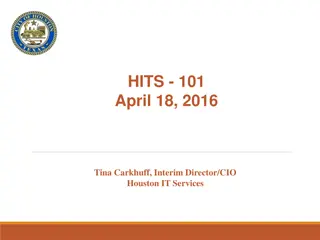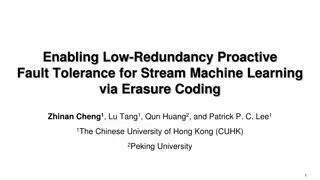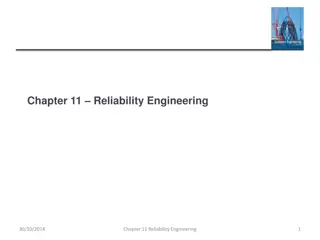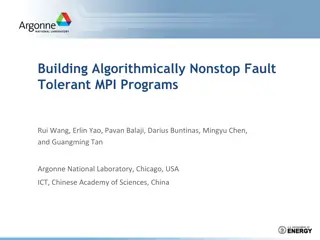Redundancy in Fault Tolerant Computing Lecture by Prof. Cinzia Bernardeschi
This content covers the importance of fault tolerant computing in safety-critical systems, such as transport and medicine. It discusses forms of redundancy like hardware, information, timing, and software redundancy. The lecture outlines why fault tolerance is crucial for computer-based systems and explores the effectiveness of fault tolerance in ensuring operational functionality during malfunctions.
Download Presentation

Please find below an Image/Link to download the presentation.
The content on the website is provided AS IS for your information and personal use only. It may not be sold, licensed, or shared on other websites without obtaining consent from the author.If you encounter any issues during the download, it is possible that the publisher has removed the file from their server.
You are allowed to download the files provided on this website for personal or commercial use, subject to the condition that they are used lawfully. All files are the property of their respective owners.
The content on the website is provided AS IS for your information and personal use only. It may not be sold, licensed, or shared on other websites without obtaining consent from the author.
E N D
Presentation Transcript
Redundancy in Fault Tolerant Computing Lecture 1 Prof. Cinzia Bernardeschi Department of Information Engineering Univerisity of Pisa, Italy cinzia.bernardeschi@unipi.it May 7-10, 2019 Thessaloniki, Greece
Outline fault tolerant computing: why and what computer-based systems: faults and failures forms of redundancy: - Hardware redundancy - Information redundancy - Timing redundancy - Software redundancy effectiveness of fault tolerance May 7-10, 2019 Redundancy in Fault Tolerant Computing 2
Textbook and other references [Sieviorek et al. 1998] D. P. Siewiorek R.S. Swarz, Reliable Computer Systems Design and Evalutaion, 2ndEd. Digital Press, 1998, chapter . [Avizienis et al. 2004] A. Avizienis, J.C. Laprie, B. Randell, C. Landwehr. Basic Concepts and Taxonomy of Dependable and Secure Computing. IEEE Transactions on Dependable and Secure Computing, Vol. 1, N. 1, 2004 [Popov et al. 2001] P.Popov, L. Strigini, The Reliability of Diverse Systems: a contribution using Modelling of the Fault Creation Process, Intern. Conf. on Dependable Systems and Networks, DSN 2001. May 7-10, 2019 Redundancy in Fault Tolerant Computing 3
Fault tolerant computing: why and what Computers are increasingly used in safety-critical systems: - transport (automotive, railways, aerospace, ...) - medicine - process control - .... Future safety-critical systems will be more automated and more dependent on computers Fault tolerant computing: the ability of the system to deliver the expected functionality during its operational life also in case of malfunctions ( important in safety-critical systems, systems whose failure may result in death or serious injury to people, loss or serious damage of equipment, or environmental harm) May 7-10, 2019 Redundancy in Fault Tolerant Computing 4
Transport systems: Aerospace http://www.aviationcoaching.com/wp-content/uploads/2015 /08/fly-by-wire-system.jpg Earliest aircraft: controlled by the pilot using the steel cables, pulleys and hydraulic actuators Fly-by-wire (FBW) system: all commands and signals are transmitted electrically along wires. These signals are sent to flight-control computers (FCS) that reconvert the electrical impulses into instructions for control surfaces like wing flaps or the tail. Potentiometers in the control surfaces measure their position and transmit that data back to the flight computer. Flight computers can be programmed to carry out adjustments to control surfaces automatically. May 7-10, 2019 Redundancy in Fault Tolerant Computing 5
Transport systems: Automotive Sensing and Computing in Cars Over 80 different embedded processors, interconnected with each other. Key ECUs (Electronic Control Unit): Engine Control Modul (ECM) Electonic Brake Control Module (EBCM) Transmission Control Module (TCM) Vehicle Vision System (VVS) Navigation Control Module (NCM) Main vehicle control systems replaced with electronic controls (no physical connection): throttle - Electronic Throttle Control brakes - Brake-by-Wire steering - Steer-by-Wire May 7-10, 2019 Redundancy in Fault Tolerant Computing 6
Fault tolerant computer-based systems For a computer based safety-critical system, the safety of the system depends strongly on its computers. Faults are unexpected events that may compromise the system functionality Faults in computer systems: hardware faults (e.g., stack-at 0 of a line, memory cell bit flip) software faults (e.g., a bug in the code) Types of faults: Design faults:unintended system function due to incomplete problem description Human interaction faults: the system includes the operator Hursh environment faults: electrical damage, wide temperature range , cosmic ray particle General questions: How to build dependable computer-based systems. Can we justifiably trust the dependability of such systems? May 7-10, 2019 Redundancy in Fault Tolerant Computing 7
Fault tolerant computer-based systems 1. a system is as strong as its weakest component Hw and sw systems relaying on hidden components 2. small hidden faults may have large effects (digital machine) Computer failures differ from failures of other equipment Subtler failures than breaking down or stopping working , .. The computer is used to store information: there are many ways information can be wrong, many different effects both within and outside the computer May 7-10, 2019 Redundancy in Fault Tolerant Computing 8
Chain of threats: Faults -> Errors -> Failures Taken from [Avizienis et al. 2004] May 7-10, 2019 Redundancy in Fault Tolerant Computing 9
Replication Make available - two or more copies of data item that may be corrupted - a mechanism that compares them and declares an error if they differ The two copies must be unlikely to be corrupted together and in the same way Examples: Duplicated circuitry, Transmit messages twice, Store data in two separate places (e.g. mirrored disks) Replication: can have a very important impact on a system in the area of performance, size, weight, power consumption and others May 7-10, 2019 Redundancy in Fault Tolerant Computing 10
Redundancy in fault tolerant computing HARDWARE REDUNDANCY Physical replication of hw (the most common form of redundancy) The cost of replicating hw within a system is decreasing because the costs of hw is decreasing INFORMATION REDUNDANCY Addition of redundant information to data in order to allow fault detection and fault masking TIME REDUNDANCY Attempt to reduce the amount of extra hw at the expense of using additional time SOFTWARE REDUNDANCY Tolerating faults in software May 7-10, 2019 Redundancy in Fault Tolerant Computing 11
HARDWARE REDUNDANCY May 7-10, 2019 Redundancy in Fault Tolerant Computing 12
Hardware redundancy Passive fault tolerant techniques use fault masking to hide the occurrence of faults rely upon voting mechanisms to mask the occurrence of faults do not require any action on the part of the system / operator generally do not provide for the detection of faults Active fault tolerance techniques use fault detection, location and recovery detect the existence of faults and perform some actions to remove the faulty hw from the system require the system to perform reconfiguration to tolerate faults common in applications where temporary, erroneous results are acceptable while the system reconfigures (satellite systems) Hybrid approach very expensive often used in critical computations in which fault masking is required to prevent momentary errors and high reliability must be achieved May 7-10, 2019 Redundancy in Fault Tolerant Computing 13
Passive fault tolerance technique:TMR 1. Triple Modular Redundancy (TMR) fault masking Module 1 output Module 2 Voter is a single point of failure Voter Module 3 Triplicate the hw (processors, memories, ..) and perform a majority vote to determine the output - 2/3 of the modules must deliver the correct results - effects of faults neutralised without notification of their occurrence - masking of a failure in any one of the three copies Good for transient faults For permanent faults, since the faulty module is not isolated, the fault tolerance decreases May 7-10, 2019 Redundancy in Fault Tolerant Computing 14
Cascading TMR with triplicated voters Taken from [Siewiorek etal., 1998] The effect of partitioning of modules (A, B, C) is that the design can withstand more failures than the solution with only one large triplicated module The partition cannot be extended to arbitrarily small modules, because reliability improvement is bounded by the reliability of the voter Triplicated voters: voter errors propagates only of one step May 7-10, 2019 Redundancy in Fault Tolerant Computing 15
TMR: the Voter Reliable Voters Hardware voters are bit voters that compute the majority on n input bits. Optimal designs of hardware voters with respect to circuit complexity, number of logic levels, fan-in and fan- out and power dissipation 1 bit voter Difficulties OUT = AB + BC + AC Delay in signal propagation: - due to the voter - due to multiple copies synchronisation Trade-off : achieved fault tolerance vs hw required May 7-10, 2019 Redundancy in Fault Tolerant Computing 16
Problems with voting procedure on analog signals using multiple analog to digital convertes and performing bit-by-bit voting on their digital output is not satisfactory The three results from the analog to digital converters may not completely agree, for example, they could produce a result which differs for the least-significant bit even if the exact signal is passed through the same converter perform voting in the analog domain: average the three signals choose the mean of the two most most similar signals choose the median of the three signals (pseudo voting) May 7-10, 2019 Redundancy in Fault Tolerant Computing 17
N-Modular Redundancy 2. NMR N is made an odd number Coverage: m faulty modules, with N = 2m +1 5MR: tolerates 2 faulty modules 7MR: tolerates 3 faulty modules .. May 7-10, 2019 Redundancy in Fault Tolerant Computing 18
Active hw redundancy 1. Duplication with comparison scheme (Error detection) Two identical pieces of hw (Module1 and Module 2) are employed they perform the same computation in parallel when a failure occurs, the two outputs are no more identical and a simple comparison detects the fault Then the comparator (hw component) selects the correct output and reconfigure the switch to select the correct value the comparator must select the correct value Dual-modular redundancy (also Duplex system) Module 1 output input comparator switch Module 2 May 7-10, 2019 Redundancy in Fault Tolerant Computing 19
Active hw redundancy: the comparator Assumption: the two copies must be unlikely to be corrupted together in the same way The comparator applies checks to select the correct output Types of checks -Coding -Specification checks (use the definition of correct result ) Example: Specification: find the solution of an equation Check: substitute results back into the original equation -Self-checking circuitry -Reversal Checks Assumption: the specified function of the system is to compute a mathemathical function F and the function has an inverse function F , such that F (F(x))=x Check: let output = F(input). Compute F (output) and verify that F (output) = input - Reasonableness Checks Divide by 0 Acceptable ranges of variables Acceptable transitions Probable results - .. May 7-10, 2019 Redundancy in Fault Tolerant Computing 20
Active hw redundancy: the comparator Problems need to check if the output data are valid. The comparator may not be able to perform an exact comparison, depending on the application area (digital control applications) faults in the comparator may cause an error indication when no error exists (false postive) or possible faults in duplicated modules are never detected (false negative) Coverage detects all single faults except those of the comparison element Advantages simplicity, low cost, low performance impact of the comparison technique, applicable to all levels and areas May 7-10, 2019 Redundancy in Fault Tolerant Computing 21
Active redundancy 2. Stand-by sparing (error detection, reconfiguration) Part of the modules are operational, part of the modules are sparesmodules (used as replacement modules) The switch can decide no longer use the value of a module (fault detection and localization). The faulty module is removed and replaced with one of the spares. - hot spares the spares operate in synchrony with the on line modules, and they are prepared to take over Module 1 error detection input output - warm spares the spares are running but receive inputs only after switching Module 2 ... error detection switch - cold spares the spares are unpowered until needed to replace a faulty module Module n error detection As long as the outputs agree, the spares are not used. May 7-10, 2019 Redundancy in Fault Tolerant Computing 22
Different schemes can be implemented Pair-and-spare approach - A module is a duplex system, pairs connected by a comparator Module 1 comparator - Duplex systems are connected to spares by a switch Module 2 - As long as the two outputs agree, or the comparator can detect the right value, the spare is not used. input output - Otherwise, the comparator signals the switch that it is not able to compute the right value and the switch operates a replacemnet using the spare. Module 1 comparator switch Module 2 spare Pair results are used in a spare arrangment. Spare components at coarser granularity. Not all four copies must be synchronised (only the two pairs) May 7-10, 2019 Redundancy in Fault Tolerant Computing 23
Hybrid approaches Combine both the active and passive approaches Very expensive in terms of the amount of hw required to implement a system Applied in commercial systems, safety critical system (aviation, railways, ) NMR with spares (Reconfigurable NMR): Modules arranged in a voting configuration - spares to replace faulty units - rely on detection of disagreements and determine the module(s) not agreeing with the majority May 7-10, 2019 Redundancy in Fault Tolerant Computing 24
Reconfigurable NMR - N redundant module configuration (active modules) Disagreement detection Fault detection unit Module 1 . . - Voter (votes on the output of active modules) . . Module N - The Fault detection units 1) compares the output of the Voter with the output of the active modules 2) replaces modules whose output disagree with the output of the voter with spares Active units outputs Spare Module 1 . . SWITCH (select N out-of N+M) Reliablity as long as the spare pool is not empty . . Voter Spare output Module M Coverage TMR with one spare can tolerate 2 faulty modules (mask the first faulty module; replace the module; mask the second faulty module) May 7-10, 2019 Redundancy in Fault Tolerant Computing 25
Hw redundancy techniques: summary Key differences Passive: rely on fault masking Active: rely on error detection, location and recovery Hybrid: emply both masking and recovery Passive provides fault masking but requires investment in hw (5MR can tolerate 2 faulty modules) Active has the disadvantage of additional hw for error detection and recovery, sometimes it can produce momentary erroneous outputs Hybrid techniques have the highest reliability but are the most costly (3MR with one spare can tolerate 2 faulty modules) May 7-10, 2019 Redundancy in Fault Tolerant Computing 26
INFORMATION REDUNDANCY May 7-10, 2019 Redundancy in Fault Tolerant Computing 27
Coding Information is represented with more bits that strictly necessary: says, an n-bit information chunck is represented by n+c= m bits Set of all possible words Among all the possible 2m configurations of the m bits, only 2n represent acceptable values (code words) 2m Set of code words if a non-code word appears, it indicates an error in transmitting, or storing, or retrieving 2n Parity code for each unit of data, e.g. 8 bits, add a parity bit so that the total number of 1 s in the resulting 9 bits is odd receiver node sender node 10100000 1 10100100 1 communication channel byte parity bit one bit flip Two bit flips are not detected not a codeword May 7-10, 2019 28 Redundancy in Fault Tolerant Computing
Coding Codes encoding: the process of determining the c bit configuration for a n bit data item decoding: the process of recovering the original n bit data from the m bit total bit Separable code: a code in which the original information is appended with new information to form the codeword. The decoding process consists of simply removing the additional information and keeping the original data Nonseparable code: requires more complicated decoding procedures Parity code is a separable code Additional information can be used for error detection and may be for error correction May 7-10, 2019 Redundancy in Fault Tolerant Computing 29
Examples of codes boxed words: code words Parity-code odd parity 3-bit words 4 code words 4-bit words 8 code words 4-bit words 8 code words May 7-10, 2019 Redundancy in Fault Tolerant Computing 30
Examples of codes m/n code: m bit equal to 1 CD - complemented duplication 2/4 code 4-bit words - 4 code words 4-bit words - 6 code words May 7-10, 2019 Redundancy in Fault Tolerant Computing 31
Distances and data spaces Hamming distance between two data items: count the number of bits that are different Parity-code: Hamming distance 2 A code such that the Hamming distance between two code words is > k will detect all errors that flip up to k bits 001 101 Memories of computer systems. Parity bit added before writing the memory. Parity bit is checked when reading. 111 011 000 100 Useful distance measures depend on type of data and faults 010 Bank account numbers should be such that mistyping a digit does not credit the wrong account. 110 undetectable detectable May 7-10, 2019 Redundancy in Fault Tolerant Computing 32
Codes for error correction Minimum Hamming distance: minimum distance between two code words correctable A code such that the minimum Hamming distance is k will detect up to k-1 single bit errors uncorrectable correctable A code such that the minimum Hamming distance is k will correct up to d errors, where k = 2d +1 Hamming distance 3: detects 1 or 2 bits errors correct 1 bit error The corrupted data is closer to the correct data than to any other code word May 7-10, 2019 Redundancy in Fault Tolerant Computing 33
Arithmetic Arithmetic codes codes An arithmetic code guarantees that if inputs are code words and the operation is performed correctly results are code words too Arithmetic operation Implementation of the arithmetic operation (hardware or software) must be modified to operate on the code The set of code words of an arithmetic code A is closed with respect to a specific set of operations. A(b*c) = A(b) * A(c ) where * is one of a set of operations 3N codes Multiply the data by 3 (this add 2 bits of redundancy) Error checking is performed by confirming that the received word is divisible by 3 May 7-10, 2019 Redundancy in Fault Tolerant Computing 34
Checksumming applied to large block of data in memories coverage: single fault Received data Original data dn dn-1 rn rn-1 checksum for a block of n words is formed by adding together all of the words in the block modulo-k, where k is arbitrary (one of the least expensive method) d2 r2 d1 r1 - the checksum is stored with the data block Checksum on Original data Checksum on received data - when blocks of data are transferred (e.g. data transfer between mass-storage device) the sum is recalculated and compared with the checksum compare Received version of checksum Code word = block + checksum - checksum is basically the sum of the original data May 7-10, 2019 Redundancy in Fault Tolerant Computing 35
Checksumming Disadvantages - if any word in the block is changed, the checksum must also be modified at the same time - allow error detection, no error location: the detected fault could be in the block of s words, the stored checksum or the checking circuitry - single point of failures for the comparison and encoder/detector element Different methods differ for how summation is executed May 7-10, 2019 Redundancy in Fault Tolerant Computing 36
Error correcting codes -ECC Two-dimensional parity row parity Odd parity n-bit words 1 0 1 . 0 1 0 0 1 . 1 1 1 1 1 . 0 0 1 0 0 . 0 0 parity error k words 0 column parity parity error Error location is possible for single-bit error: one error in the row parity vector, one error in the column parity vector A single-bit error in the parity column or parity row column is detected Single-error correcting code (SEC): detect and correct 1-bit error May 7-10, 2019 Redundancy in Fault Tolerant Computing 37
Hamming Code (I) Parity bits spread through all the data word Parity bits all bit positions that are powers of two : 1, 2, 4, 8, etc. Data bits all other bit positions (number the bit positions starting from 1: bit 1, 2, 3, etc..) Taken from: http://en.wikipedia.org/wiki/Hamming_code#Hamming_codes Parity bit pj covers all bits whose position has the j least significant bit equal to 1 Each data bit is included in a unique set of 2 or more parity bits, as determined by the binary form of its bit position May 7-10, 2019 Redundancy in Fault Tolerant Computing 38
Hamming code (II) Taken from: http://en.wikipedia.org/wiki/Hamming_code#Hamming_codes Parity bit p1 covers all bit positions which have the least significant bit set: bit 1 (the parity bit itself), 3, 5, 7, 9, etc. Parity bit 4 covers all bit positions which have the third least significant bit set: bits 4 7, 12 15, 20 23, etc. Parity bit 8 covers all bit positions which have the fourth least significant bit set: bits 8 15, 24 31, 40 47, etc. Parity bit p2 covers all bit positions which have the second least significant bit set: bit 2 (the parity bit itself), 3, 6, 7, 10, 11, etc. May 7-10, 2019 Redundancy in Fault Tolerant Computing 39
Hamming code (III) Taken from: http://en.wikipedia.org/wiki/Hamming_code#Hamming_codes Overlap of control bit: a data bit is controlled by more than one parity bits Minimum Hamming distance: 3 Double-error detection code Single-error correction code SEC-DED code May 7-10, 2019 Redundancy in Fault Tolerant Computing 40
Self checking circuitry Necessity ofreliance on the correct operation of comparators and code checkers that are used as hard-core for fault tolerant systems Self-checking circuit given a set of faults, a circuit that has the ability to automatically detect the existence of the fault and the detection occurs during the normal course of its operations Typically obtained using coding techniques: circuit inputs and outputs are encoded (also different codes can be used) Basic idea: fault free + code input -> output: correct code word fault + code input -> output: (correct code word) or (non code word) May 7-10, 2019 Redundancy in Fault Tolerant Computing 41
Self checking circuitry Self-testing circuit: if, for every fault from the set, the circuit produces a noncode output for at least one code input (each single fault is detectable) Fault-secure circuit: if, for every fault from the set, the circuit never produces a incorrect code output for a code input (i.e. correct code output or noncode output) Totally self-checking (TSC): if the circuit is self-testing and fault- secure May 7-10, 2019 Redundancy in Fault Tolerant Computing 42
two-input TSC comparator two signal input comparator (A, B) output equal to 0 if inputs are equal; 1 otherwise A B C 0 0 0 0 1 1 1 0 1 1 1 0 C B Fault assumption: - single fault - stuck-at-1/stuck-at-0 of each line in the circuit A A : A1 A2 Coding: 1/2 (dual-rail signal: coded signal whose two bits are always complementary) 0 : 0 1 1 : 1 0 May 7-10, 2019 Redundancy in Fault Tolerant Computing 43
two-input TSC comparator output 0 if inputs are equal; 1 otherwise Fault free A =0, B =1 different input m=1, n =1, q=0 o = 0, p=1, r= 1 c2=0 c1=1 c1c2: code word Output = c1 = 1 correct vvvvv 0 0 vvvvv vvvvv 1 1 vvvvv 1 vvvvv 0 vvvvv Taken from:[Siewiorek et al., 1998] May 7-10, 2019 Redundancy in Fault Tolerant Computing 44
two-input TSC comparator output 0 if inputs are equal; 1 otherwise 0 Faulty: A=0, B=1 different input m: stuck-at-0 c2 = 1 c1 = 1 c1c2: non code word Output = error 0 1 1 1 0 Taken from:[Siewiorek et al., 1998] May 7-10, 2019 Redundancy in Fault Tolerant Computing 45
two-input TSC comparator output 0 if inputs are equal; 1 otherwise 0 Faulty: A=0, B=1 different input m: stuck-at-1 c2=0 c1=1 c1c2: code word output = c1 = 1 correct 0 1 1 1 0 Taken from:[Siewiorek et al., 1998] May 7-10, 2019 Redundancy in Fault Tolerant Computing 46
two-input TSC comparator Taken from:[Siewiorek et al., 1998] For each fault, there exists at least one input configuration such that the output is a non code word If the output is a code word, the output is correct May 7-10, 2019 Redundancy in Fault Tolerant Computing 47
n-input TSC comparator n-input TSC comparator: tree of two input self checking comparators May 7-10, 2019 Redundancy in Fault Tolerant Computing 48
TIME REDUNDANCY May 7-10, 2019 Redundancy in Fault Tolerant Computing 49
Time redundancy techniques (I) Attempt to reduce the amount of extra hw at the expense of using additional time Repetition of computations - compare the results to detect faults - re-execute computations (disagreement disappears or remains) good for transient faults no protection against permanent fault - problem of guaranteeing the same data when a computation is executed Data Store result Computation time t0 error Compare results time t0+d Encode Data Decode result Store result Computation Data May 7-10, 2019 Redundancy in Fault Tolerant Computing 50
